William Beechey
| Sir William Beechey | |
|---|---|
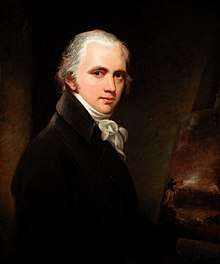 Sir William Beechey, self-portrait, ca.1800 | |
| Born |
12 December 1753 Burford, Oxfordshire |
| Died |
28 January 1839 (aged 85) London |
| Nationality | British |
| Known for | Portrait painting |
| Spouse(s) | Anne |
Sir William Beechey RA (12 December 1753 – 28 January 1839) was a leading English portraitist of the golden age of British painting.[1]
Early Life
Beechey was born at Burford, Oxfordshire, on 12 December 1753, the son of William Beechey, a solicitor, and his wife Hannah Read. Both parents died when he was still quite young, and he and his siblings were brought up by his uncle Samuel, a solicitor who lived in nearby Chipping Norton.[2] The uncle was determined that the young Beechey should likewise follow a career in the law, and at an appropriate age he was entered as a clerk with a conveyancer near Stow-on-the-Wold. But as the Monthly Mirror later recorded in July 1798, he was: Early foredoomed his [uncle's] soul to cross/ And paint a picture where he should engross.
Career
%2C_c.1797-1802.jpg)
Beechey was admitted to the Royal Academy Schools in 1772, where he is thought to have studied under Johan Zoffany. He first exhibited at the Academy in 1776. His earliest surviving portraits are small-scale full-length and conversation pieces which are reminiscent of Zoffany. In 1782, he moved to Norwich, where he gained several commissions, including a portrait of Sir John Wodehouse and a series of civic portraits for St. Andrew's Hall, Norwich. By 1787, he had returned to London, and in 1789, he exhibited a celebrated portrait of John Douglas, Bishop of Carlisle (now in Lambeth Palace). Beechey’s career during this period is marked by a succession of adept and restrained portraits in the tradition of Sir Joshua Reynolds.
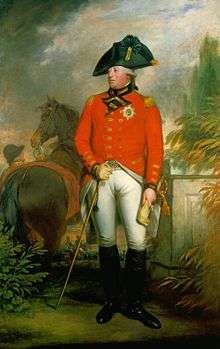
Beechey’s style perfectly suited the conventional taste of the royal family, and in 1793, he was commissioned to paint a full-length portrait of Queen Charlotte and subsequently named as her official portrait painter. That same year, he was elected as an associate member of the Royal Academy. Following his royal appointment, the number of royal commissions he undertook increased markedly, and in 1797 he exhibited six royal portraits. In 1798, he was elected a full member of the Royal Academy[3] and painted George III and the Prince of Wales Reviewing Troops for that year’s academy’s exhibition. This enormous composition depicts King George III, the Prince of Wales and staff officers on horseback at an imagined cavalry review in Hyde Park. The king was reported to be delighted with the painting and rewarded Beechey with a knighthood.[4] Joseph Farington's Diaries give many accounts of Beechey's relations with the royal family during this period, including his his temporary fall from favour in 1804, which Farington attributes to the vagiaries of George III’s mental condition.
Beechey's portraits of the turn of the century are considered to be his most colourful and lively. They are closer to the flamboyant and free techniques employed by his younger rivals, John Hoppner and Sir Thomas Lawrence.
Royal patronage resumed in around 1813, when Beechey was appointed portrait painter to Prince William Frederick, Duke of Gloucester, and culminated with his appointment in 1830 as principal portrait painter to King William IV. In 1836, Beechey retired to Hampstead and on 9-11 June that year, the contents of his studio along with his collection were sold at Christie’s.
Although capable of impetuousness and irascibility, Beechey was known for his generosity to students. In particular, he took a close interest in the career of the young John Constable.
Subjects
During a prolific career spanning half a century, Beechey painted many of the leading figures of his day. His sitters included:
Family
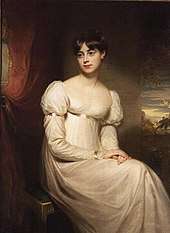
William Beechey's first marriage was to Mary Ann Jones (ca. 1760–1793) in 1772 (other sources say 1778). They had five children:
- Emma Amalia Beechey (1784–1859)
- Henry William Beechey (1788–4 August 1862) British painter and Egyptologist
- Charles Beechey (born 1789)
- Caroline Beechey (born 1790)
- Harriet Beechey (born 1792)
He secondly married the successful miniature painter Anne Phyllis Jessop (3 August 1764–14 December 1833) in 1793[5] and they had 16 children:
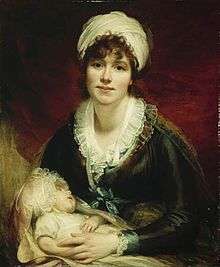
- Ann Phyllis Beechey (1794–December 1883)
- Frederick William Beechey (17 February 1796–29 November 1856), Royal Navy captain, geographer, politician
- George Duncan Beechey (1798–6 December 1852), painter
- Anna Dodsworth Beechey (born 1800)[6]
- William Nelson Beechey (3 August 1801–1 August 1878)
- Charlotte Earl Beechey (3 August 1801–28 November 1849)
- Alfred Beechey (born 24 June 1803)
- St. Vincent Beechey (7 August 1806–19 August 1899), clergyman
- Richard Brydges Beechey (17 May 1808–14 March 1895), painter and admiral in the British navy
- Jane Henrietta Frances Beechey (born 19 December 1809)
- Augusta Beechey (born 1812)
- Fredericka Anne Beechey (born 1814)
- William Ernest Beechey (born 1816)
- Frances Beechey (born 1818)
- Phyliss Beechey (born 1820)
- a daughter S. R. Beechey (born 1822)
Prices at auction
Beechey’s Portrait of James Watt sold for £153,440 at Sotheby’s on 20th March 2003.[7] His Portrait of Mirza Abu'l Hassan Khan, Envoy Extraordinary and Minister Plenipotentiary to the Court of King George III sold for £181,600 at Christie’s on 8th June 2006.[8] His Portrait of George Douglas, 16th Earl of Morton in the dress of the Royal Company of Archers sold for £481,250 at Christie’s on 5th July 2011.[9] His portrait of The Dashwood Children sold at auction for $821,000 including premium at Christie’s on 29th January 2014.[10]
Gallery
Beechey’s works are represented in many of the world’s leading collections, including the Louvre, the Smithsonian Institution, the Royal Collection, the Royal Academy of Arts, the National Portrait Gallery, London, the Tate and the Metropolitan Museum of Art.
_by_William_Beechey.jpg)
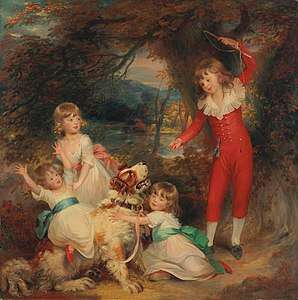 The Dashwood Children, ca.1789
The Dashwood Children, ca.1789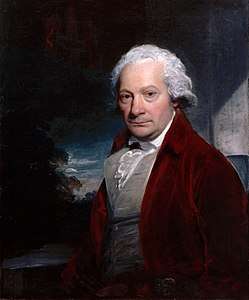 Paul Sandby RA (1731-1809), ca.1789
Paul Sandby RA (1731-1809), ca.1789_by_William_Beechey%2C_(Burford%2C_Oxforshire_1753-1839_London).jpg)
.jpg) Master James Hatch, 1796
Master James Hatch, 1796.jpg) Queen Charlotte (1744–1818), 1796-1812
Queen Charlotte (1744–1818), 1796-1812%2C_ca._1798.jpg)
.jpg)
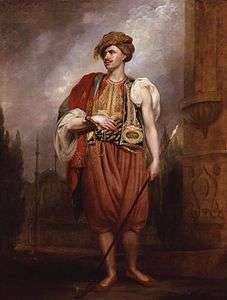 Thomas Hope, 1798
Thomas Hope, 1798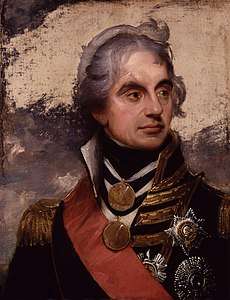
%2C_by_William_Beechey.jpg)
.jpg) James Watt (1736–1819), ca.1802
James Watt (1736–1819), ca.1802 Princess Augusta Sophia (1768–1840), ca.1802
Princess Augusta Sophia (1768–1840), ca.1802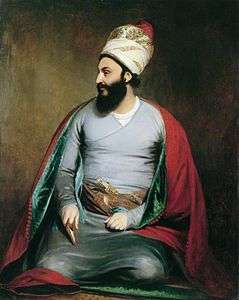 Mirza Abu'l Hassan Khan, 1809-10
Mirza Abu'l Hassan Khan, 1809-10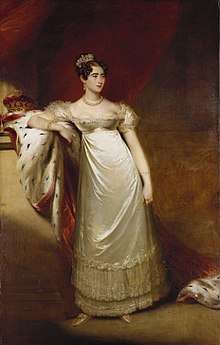
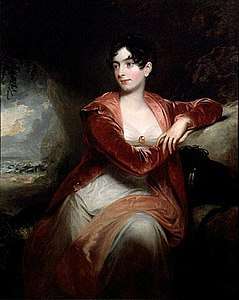 Miss Windham, 1828
Miss Windham, 1828
References
- ↑ , Le Louvre, retrieved 25 September 2018
- ↑ Roberts 1907, p. 3.
- ↑ Redgrave & Redgrave 1947, p. 131.
- ↑ Chisholm 1911.
- ↑ John Wilson, ‘Beechey, Sir William (1753–1839)’, Oxford Dictionary of National Biography, Oxford University Press, 2004; online edn, Oct 2006 accessed 2 May 2017
- ↑ Anna Dodsworth Beechey, NPG, Retrieved 2 May 2017
- ↑ , Christie’s, retrieved 25th September 2018
- ↑ , Christie’s, retrieved 25th September 2018
- ↑ , Christie’s, retrieved 25 September 2018
- ↑ , Christie’s, retrieved 25 September 2018
Sources
- Redgrave, Richard; Redgrave, Samuel (eds.) (1947) [1890]. A Century of Painters of the English School. Sampson Low, Marston.
- Roberts, W. (1907). Sir William Beechey, R.A. London: Duckworth & Co.


External links
| Wikimedia Commons has media related to William Beechey. |
- 178 paintings by or after William Beechey at the Art UK site